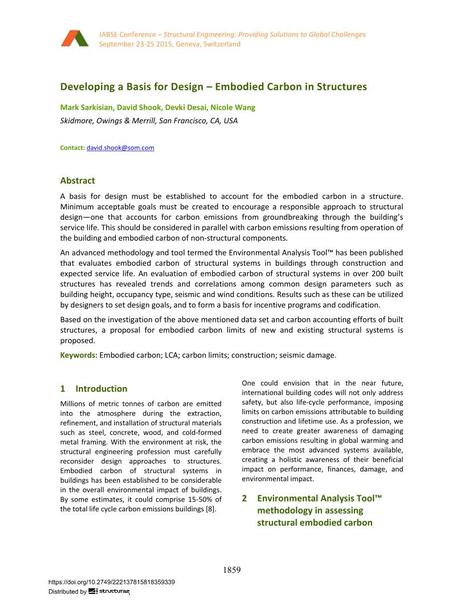Developing a Basis for Design – Embodied Carbon in Structures

|
|
|||||||||||
Bibliografische Angaben
| Autor(en): |
Mark Sarkisian
(Skidmore, Owings & Merrill, San Francisco, CA, USA)
Christopher Horiuchi (Skidmore, Owings & Merrill, San Francisco, CA, USA) David Shook (Skidmore, Owings & Merrill, San Francisco, CA, USA) |
||||
|---|---|---|---|---|---|
| Medium: | Tagungsbeitrag | ||||
| Sprache(n): | Englisch | ||||
| Tagung: | IABSE Conference: Structural Engineering: Providing Solutions to Global Challenges, Geneva, Switzerland, September 2015 | ||||
| Veröffentlicht in: | IABSE Conference Geneva 2015 | ||||
|
|||||
| Seite(n): | 1859-1866 | ||||
| Anzahl der Seiten (im PDF): | 8 | ||||
| Jahr: | 2015 | ||||
| DOI: | 10.2749/222137815818359339 | ||||
| Abstrakt: |
A basis for design must be established to account for the embodied carbon in a structure. Minimum acceptable goals must be created to encourage a responsible approach to structural design—one that accounts for carbon emissions from groundbreaking through the building’s service life. This should be considered in parallel with carbon emissions resulting from operation of the building and embodied carbon of non-structural components. An advanced methodology and tool termed the Environmental Analysis Tool™ has been published that evaluates embodied carbon of structural systems in buildings through construction and expected service life. An evaluation of embodied carbon of structural systems in over 200 built structures has revealed trends and correlations among common design parameters such as building height, occupancy type, seismic and wind conditions. Results such as these can be utilized by designers to set design goals, and to form a basis for incentive programs and codification. Based on the investigation of the above mentioned data set and carbon accounting efforts of built structures, a proposal for embodied carbon limits of new and existing structural systems is proposed. |
||||
